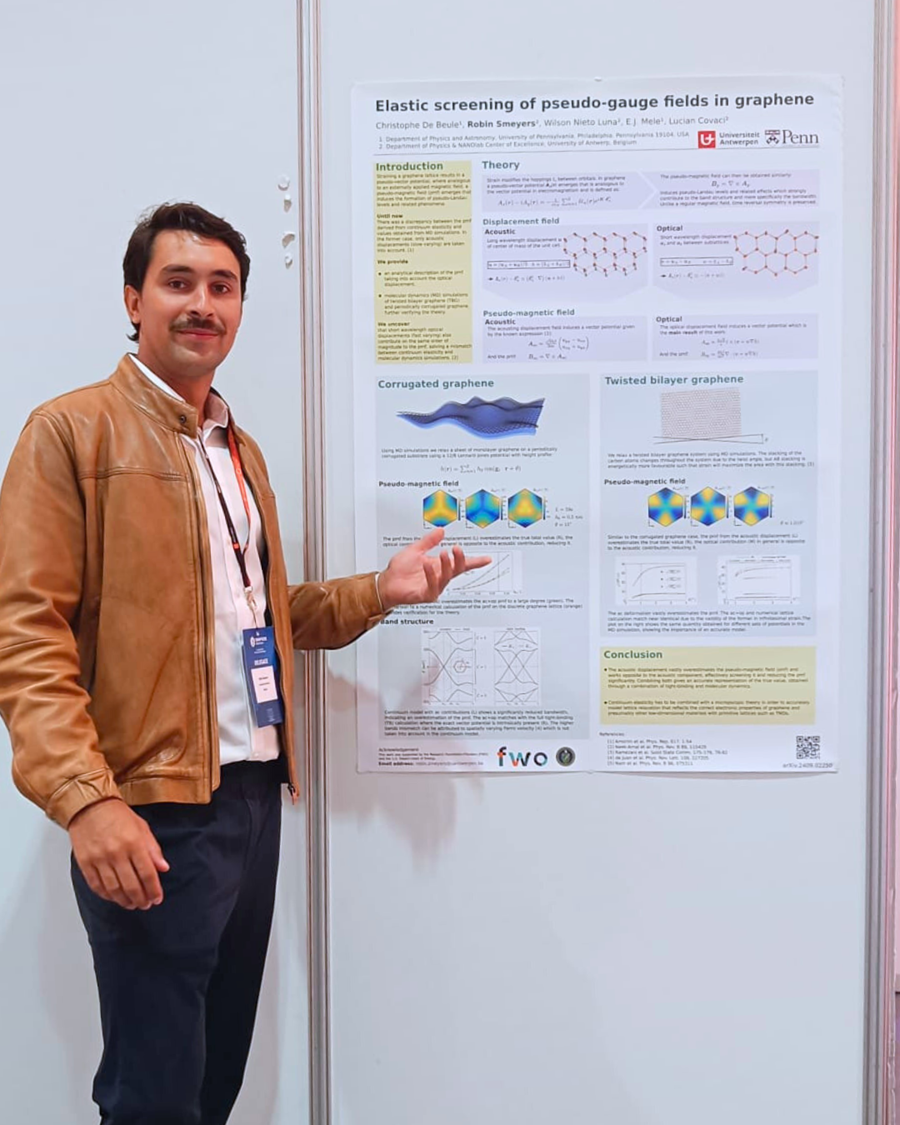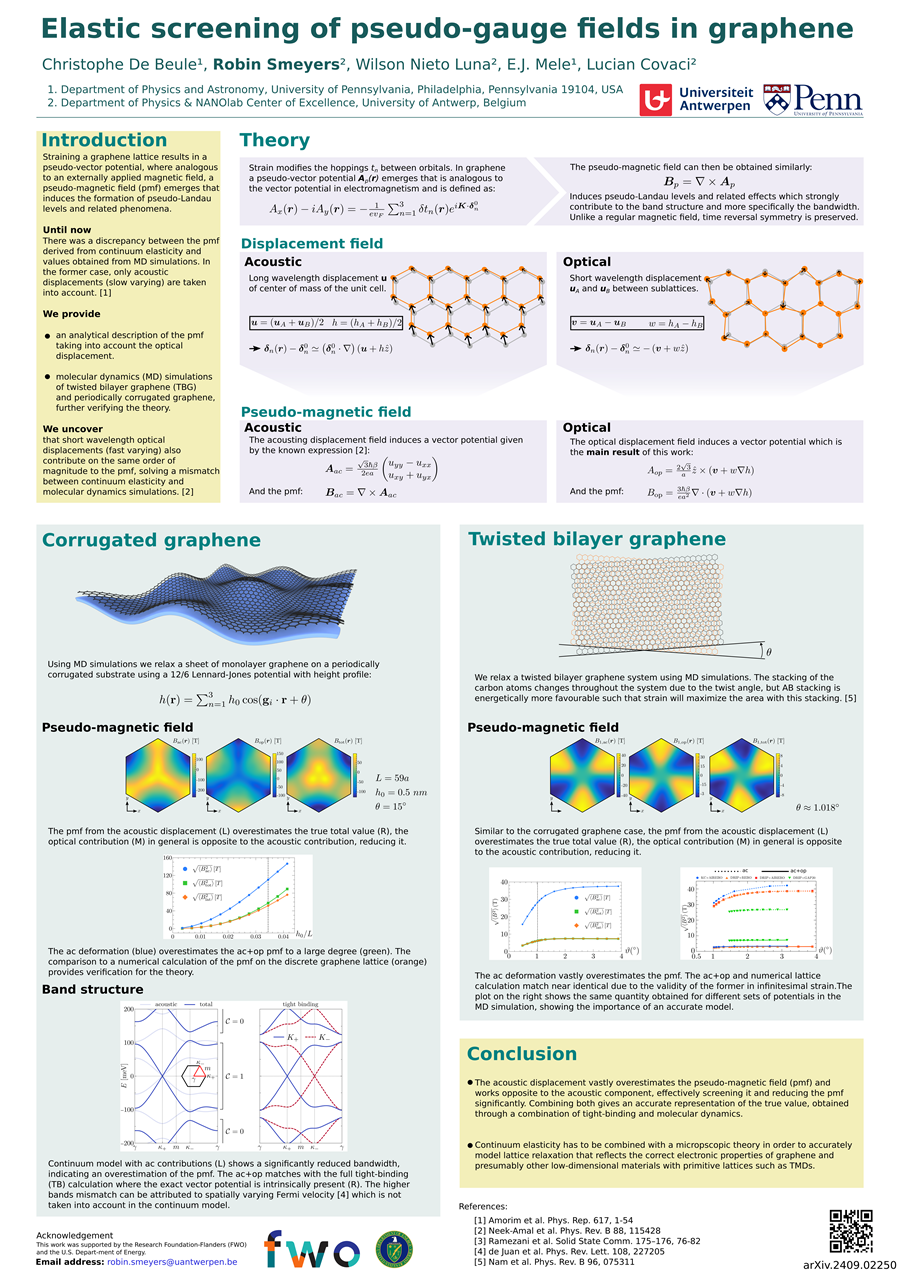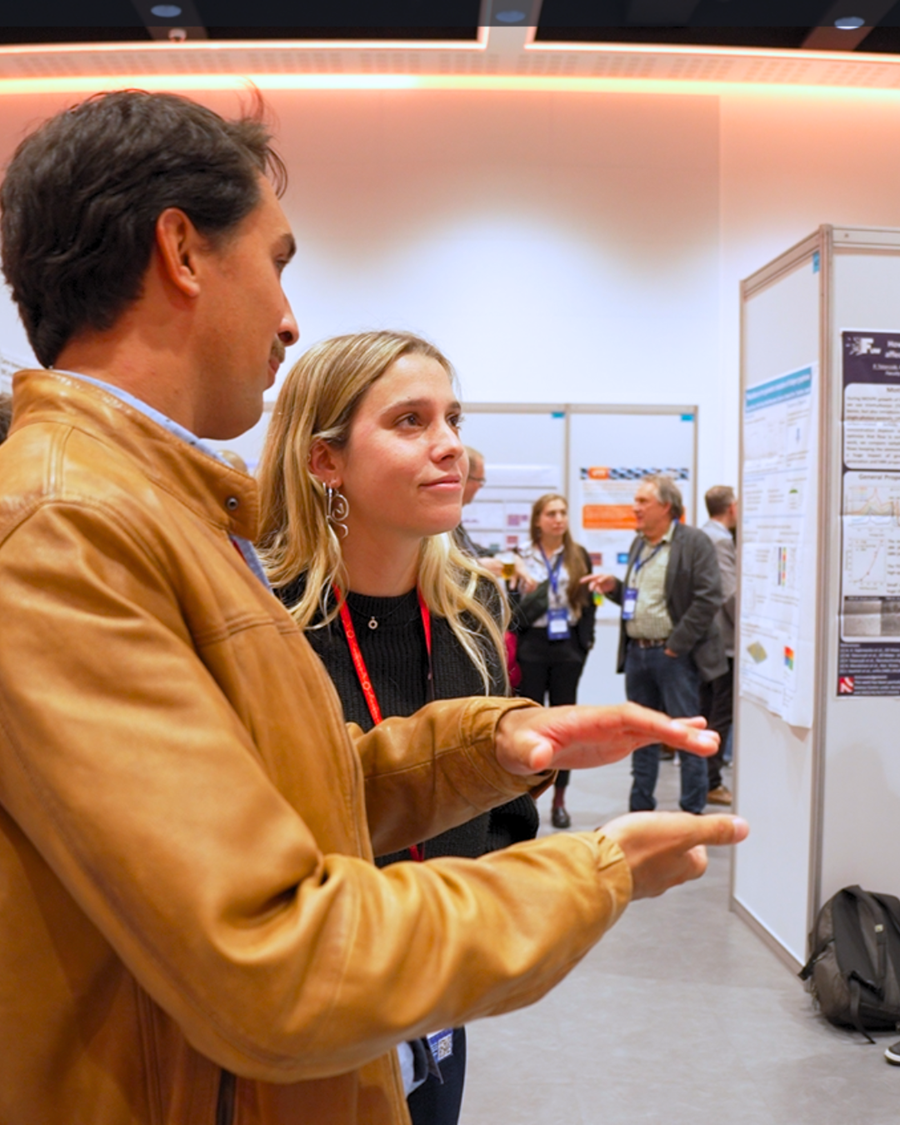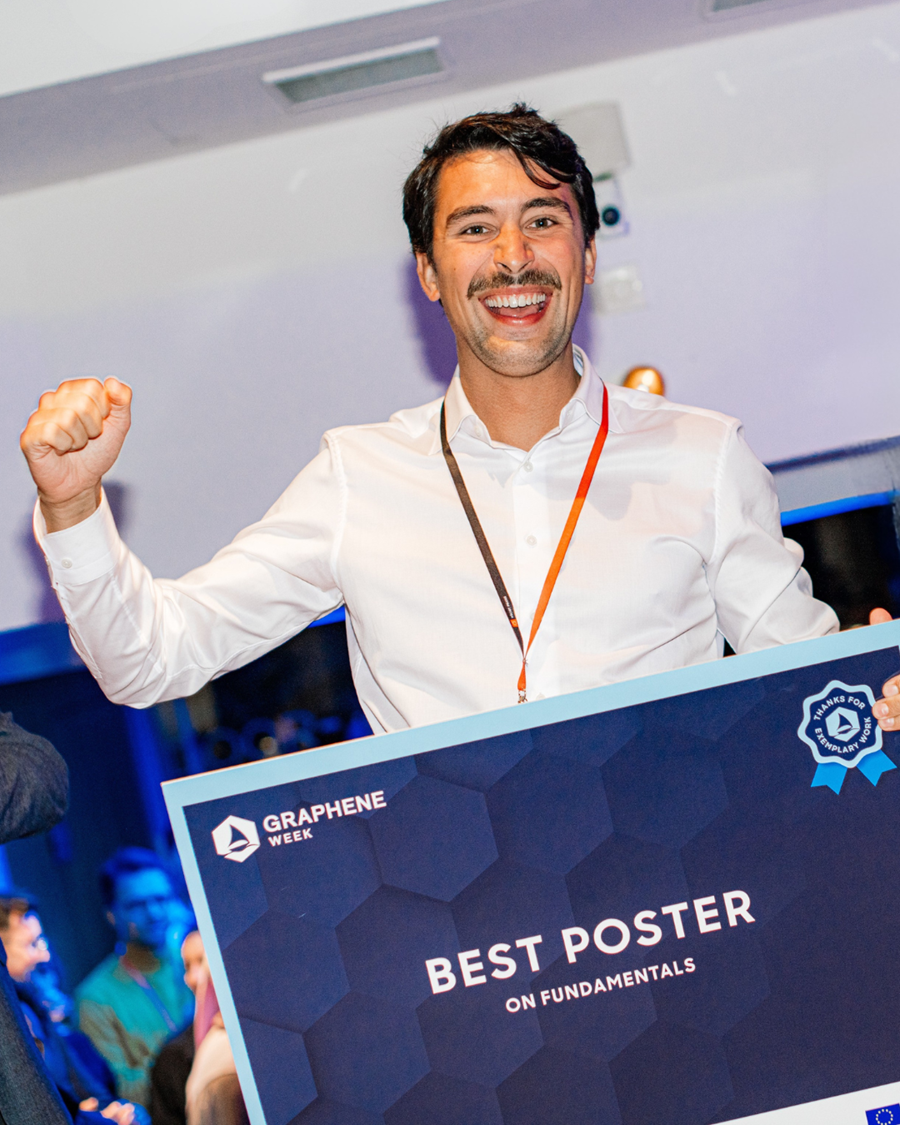Stretching the Limits of Graphene with Robin Smeyers
For Robin Smeyers, a passion for 2D materials began with a single thesis and quickly grew into a full-blown research journey. What started as a master’s project on graphene became a launchpad for academic discovery, leading him to a PhD focused on one of the most intriguing frontiers in condensed matter physics: straintronics. Robin’s work ranges from simulating balloon-like graphene structures to exploring the possibilities of room-temperature superconductors, laying the foundation for technologies that could one day transform our world.

To me, it feels like after 20 years we are still only building the foundation of a field holding the potential to further our society for many generations to come."
Poster Award Winner 2024

Elastic screening of pseudo-gauge fields in graphene
By: Robin Smeyers
Best Poster on Fundamentals 2024

I’ve always had a soft spot for space travel and ecology, so perhaps that’s where my future lies—living in a cabin by a lake on Mars, surrounded by my very own self-planted forest."

Like a good book you start to read and can’t wait to see what happens next."
How did you first start working with graphene/2D materials?
I was introduced to the world of graphene and 2D materials when my current promoter offered me a master’s thesis on the topic of graphene on hexagonal boron nitride, almost five years ago. That work became my first paper in a peer-reviewed journal and convinced me to start my PhD.
Why are you excited to work on graphene/2DM?
2D materials have truly changed the way we see the future of condensed matter. Not only do they hold these super materials like graphene, but the concept of a sheet-like material opens the door to endless creativity. Straining, twisting, and stacking are some of the most recent fields of interest; given time, it is only logical that more and more ways to use them will emerge.
To me, it feels like after 20 years we are still only building the foundation of a field holding the potential to further our society for many generations to come. It is this amazing potential that it holds that keeps me excited about my work.
Who has been the biggest influence or mentor in your career so far?
As for most PhD students this is my promoter, Lucian. We have always worked very closely together, and I learned a lot from him. Besides that, doing a PhD can be tough, and the value of close family and friends cannot be underestimated. Every success is preceded by a hundred failures, and to endure these failures, we need the mental support of other colleagues and people outside our professional lives. It is one of the most important aspects in any career, and I feel it is not talked about enough.
How did you first become interested in your current research project?
It is mainly because of my master’s thesis that I got into my current project. Both are quite similar so the transition between the two was very smooth.
What’s your research focus? What is your current research goal?
In general, the goal is to manipulate graphene in large periodic patterns, which slows down the electrons within by flattening their dispersion. As a result, electrons interact more strongly with each other, potentially leading to exotic phenomena such as superconductivity, the ability to conduct electrical current without resistance. One way to manipulate a graphene layer is by straining (deforming) it in large repeated patterns.
In my research, we specifically focus on creating strain by introducing gas atoms between the graphene and the substrate, inflating the graphene layer like a balloon and inducing strain in the process. Using computer software, we first simulate the deformation of large graphene sheets under different conditions. We then use these results to calculate how electrons behave within the sheet.
In what way can graphene and other 2DM improve this area?
That is a difficult question to answer since we are investigating the behaviour of graphene itself, rather than its applications.
Why do you feel your research is important, and what benefits could it bring to society?
My research is mainly aimed at understanding graphene itself which is useful in the development of electronic devices, a very broad topic in its own right. The ultimate dream of course is to achieve room temperature superconductivity, but this is not a realistic goal to set for myself, so instead I aim to provide yet another stepping stone in its direction.
The discovery of room-temperature superconductivity would elevate society as we know it to a new technological level. Our ability to perform computations would vastly improve, which is becoming more and more relevant with the advent of artificial intelligence. On top of that, it would drastically increase the efficiency in which energy is used, transported, and produced, possibly solving climate change to a large degree.
As an early career researcher, where do you see your field going?
I think the field of straintronics still has a lot to offer since it is quite a common property for 2D materials to be very stretchable. Besides the possible applications it provides, it is also necessary to understand its implications in order to make realistic predictions for electronic applications, since strain is present in almost every 2D material to some degree.
What do you enjoy the most in your career path?
The thing I enjoy the most is the satisfaction I get from contributing to something that will have a positive impact on society somewhere down the line. It gives me a great sense of fulfilment.
Do you have a favourite anecdote or moment from your research journey?
Funnily enough, winning the best poster prize at Graphene Week, the reason I am answering these questions. Aside from that, one of my most memorable moments was skiing in the French Alps when suddenly I got the news that my first paper had been accepted. I got so excited that I bought all my friends a round at the local chalet—only to regret it when I saw the bill.
Coincidentally, my second paper was also published while I was skiing. Maybe I should hit the slopes more often!
What is the most challenging part of your current work?
The most challenging part is making new findings that lead to more projects. Opening up more exciting avenues that can be explored often leads to a lot of parallel work and the loss of focus on the original research question. Besides that, working in academia can be tough for your mental health.
There is always a lot of thinking involved, making it very tiring and harder to focus on my day-to-day life. Also, dealing with setbacks in a work environment where no one knows the solution as a definition (because if we did, it wouldn’t be research) can lead to self-confidence issues. It is then very important to realise this, take some steps back and not be too hard on yourself.
If you could work on any dream project involving graphene/2D materials, what would it be?
I would likely prefer to stick to my own project. I’ve invested a lot of time in it, and I’m eager to see what results we might still achieve. Like a good book you start to read and can’t wait to see what happens next.
What are your plans for the future?
For now, I’m not too preoccupied with the future, as I’m focused on finishing my final year of my PhD. Academia has taught me a lot, but it has also proven to be a tough path, leaving my future uncertain.
However, I hope to stay within the scientific world, contributing to society one idea at a time. I’ve always had a soft spot for space travel and ecology, so perhaps that’s where my future lies—living in a cabin by a lake on Mars, surrounded by my very own self-planted forest.
Tell us about your experience at Graphene Week 2024. How was this event for you?
It was my first time at Graphene Week and found it to be a very enjoyable experience. Everything was well organised with nice talks and good food. The conference dinner on the river was probably the highlight for me. Perhaps I would have liked to see a bit more talks discussing theory, but seeing all the applications was already an inspirational experience for me.
How did you feel about winning the Graphene Week Best Poster Award?
It was an incredible experience, to say the least. I had put a lot of effort into my poster, but I never expected to win an actual prize, especially given the fierce competition. Receiving praise for my work was an amazing feeling, and I’m truly grateful to the organisers and attendees of the conference for giving me that opportunity.
Robin’s journey reminds us that behind every nanomaterial is a very human story filled with persistence, curiosity, and a bit of alpine celebration. His work is part of a much bigger picture, it may be too soon to promise superconductors or forest cabins on Mars, but one thing is clear: Robin Smeyers is helping to build the foundation for whatever comes next.




